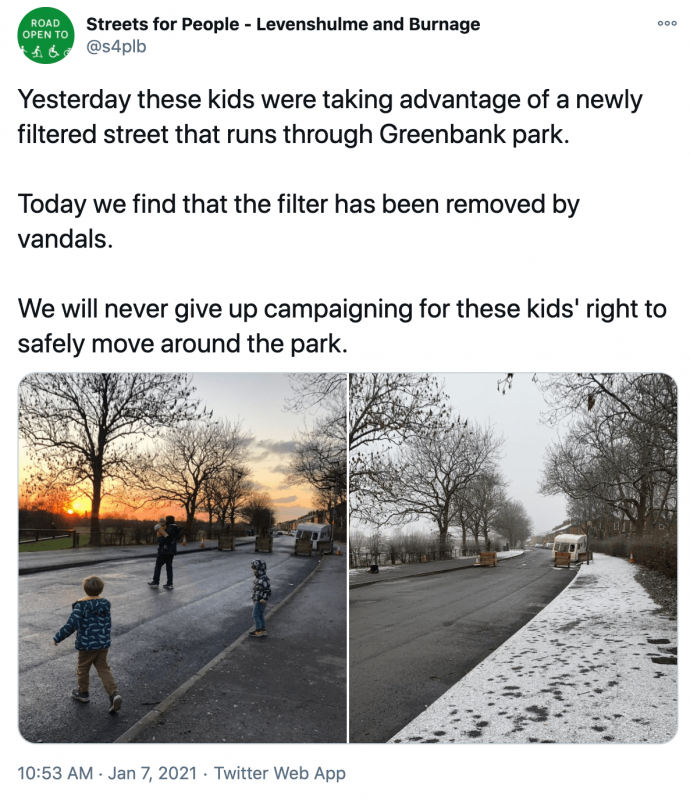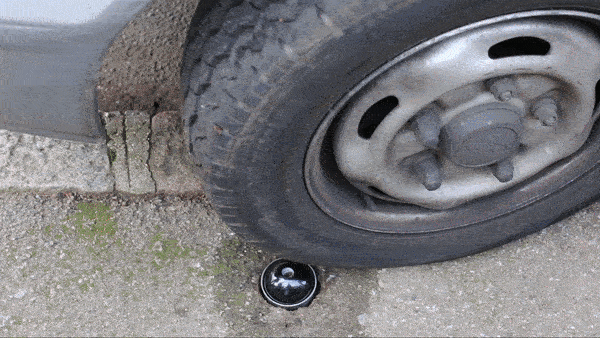
The attacks by vandals on Low Traffic Neighbourhoods (LTNs), the schemes that use bollards or planters to stop rat running and create safe spaces for walking and cycling, have continued into 2021.
The road blocks – or modal filters as they are also called – that create LTNs have long been used in The Netherlands and other countries that actively promote walking and cycling. Here in Britain, their widespread and rapid installation has been prompted by the need to provide alternatives to public transport following Covid-19 restrictions and a desperate need to reduce traffic levels – especially given the link between coronavirus deaths and air pollution.
The schemes make use of new government funds and use emergency traffic orders to bypass the conventional planning process – public consultation happens over the first six months of operation. That hasn’t stopped a vocal minority from protesting against the LTNs and in some cases vandalising them – or simply driving on pavements to avoid the road closures.

Many of the planters used to close roads are wooden planters that are relatively easy to winch onto a lorry. In light of the continuing vandalism, it’s possible a different approach is needed. Perhaps we need to dust off our CatClaw invention from a few years back.

When a car or lorry drives over a CatClaw, its weight exposes a sharp steel tube that quickly punctures the tyre. However, it poses no threat to pedestrians – a person standing on top of the device would not be heavy enough to activate it (the device pictured above is a prototype for demonstration purposes only).
The CatClaw is an extreme idea that is unlikely to be practicable, or even legal. Other than the sharpened spike hidden within, what, you may ask, is its point. The purpose of the project was to highlight the plight of the 40+ people killed each year on pavements in Britain by drivers and the many thousands of pedestrians every day who have their path blocked. In other words, the Catclaw is a crafty way to highlight the need for road danger reduction.
When it had its first outing, the CatClaw generated coverage in numerous titles including The Daily Mail, The Express, The Mirror, Metro, The Manchester Evening News…not to mention appearing on television and being seen by over 130,000 folk via YouTube.
The promotion and protections of LTNs form part of a systematic approach to road danger reduction that Britain needs so badly will not involve Catclaw or anything remotely as outlandish. As has happened in countries such as Sweden, it will involve a cultural shift – a placing of people’s needs ahead of cars. The benefits of such an approach are numerous, but include safer roads, reduced healthcare costs, greater independence for children and increased quality of life for all. However, change of this kind can occur only once people – as opposed to politicians – consider it vital. And that process starts with getting it talked about.
The work of The ETA ranges from awareness-raising projects like the CatClaw, to community roadshows promoting sustainable transport, to helping schools mount protests to demand safer road crossings. Supporting these projects is easy. Simply buy your home insurance, cycle insurance, mobility scooter cover or breakdown cover and you will be helping to fund these campaigns and many more besides. And you can rest assured that by choosing us you will not be compromising on quality or paying over the odds – we’ve been around for over 27 years and are rated as Britain’s most ethical insurance company by The Good Shopping Guide.
Do LTNs work?
Research carried on impacts of active travel interventions in Outer London between 2016-19 has found decreased car ownership and use and increased active travel in intervention areas where Low Traffic Neighbourhoods (LTNs) were introduced. Decreased car ownership and use was found only in such areas. The research suggests that to reduce car use as well as increase active travel, LTNs are an important part of the intervention toolbox.
Co-author of the research Rachel Aldred is a professor in Transport at the University of Westminster with over 25 peer reviewed papers to her name and appears in our documentary about road danger Stop Killing our Children.
Protect your bicycle
One cycle insurance policy appears much like another, but the devil is the detail. How much excess you will be charged is just one of the things that varies between providers. Another is so-called ‘new-for-old’ replacement – many insurers use this term, but if your bicycle is more than a few years old, devalue it severely. This means you are left out of pocket when you come to replace it.
0 Comments View now